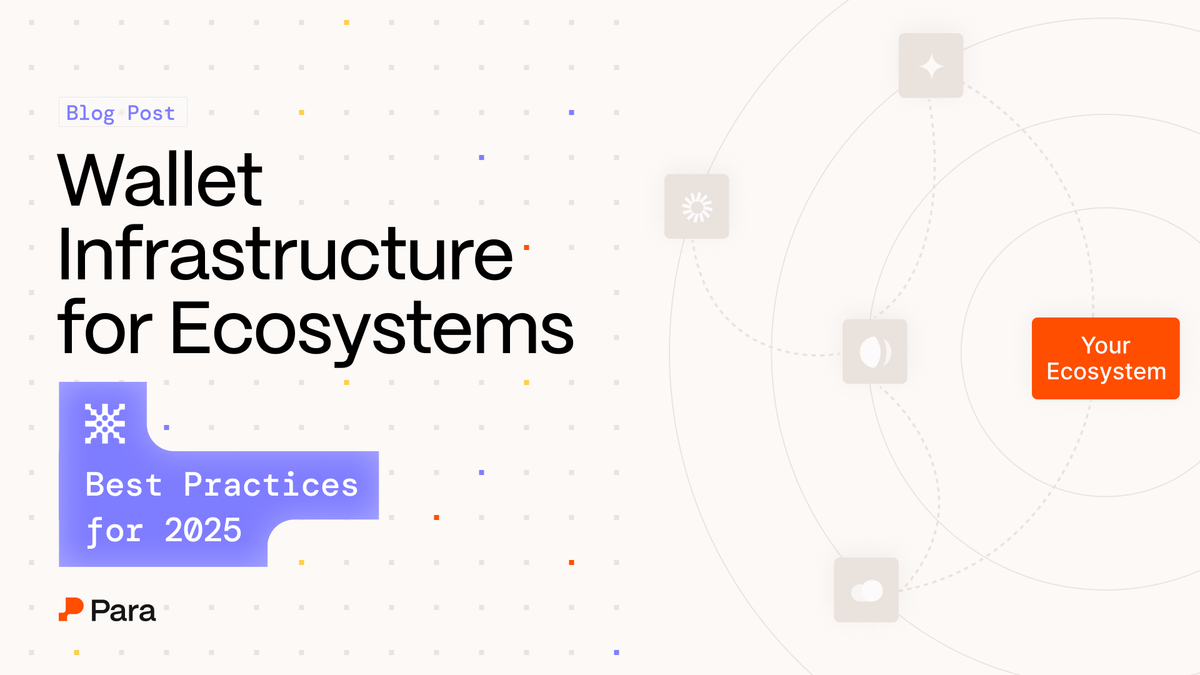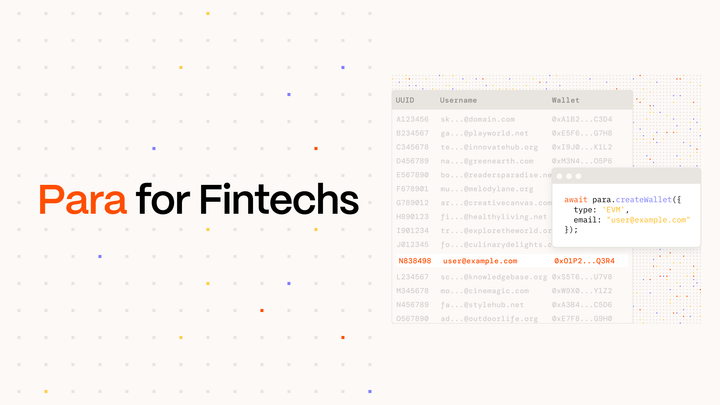Wallet Infrastructure for Crypto Ecosystems: Best Practices for 2025
Choosing a wallet provider isn’t just a developer decision; it’s an ecosystem strategy. This guide breaks down what to look for (and what to avoid)

Why Wallet Infrastructure Choices Matter Now
Crypto is shifting. Not just in the technology, but how ecosystems form. The old top-down ecosystem-first model is giving way to something new: apps at the center, ecosystems built from the bottom up.
In this new model, apps lead – and chains win by enabling them. That makes wallet infrastructure more important than ever. They shape how people onboard, where assets live, and how sticky a product becomes.
Choosing a wallet provider isn’t just a developer decision; it’s an ecosystem strategy. This guide breaks down what to look for (and what to avoid) across:
- Account portability and lock-in
- Censorship resistance and open source
- Recovery and user retention
App UX That Scales Across Your Ecosystem
Embedded wallets reduce friction, boost conversion, and make onboarding feel invisible. Most embedded wallets, however, are created in-app and stay locked-in to that specific SDK or provider, leaving users with a wallet they cannot take anywhere else.
The result? Identity gets fragmented. Balances get split. Developers are stuck rebuilding login and signing flows, and re-onboarding the same users across every new app.
Over time, this doesn’t just hurt UX. It slows growth across your entire ecosystem.
we spent nearly a full year evaluating embedded wallets as the space massively evolved—before deciding that the logical choice right now is @get_para.
— david phelps (@divine_economy) February 20, 2025
i want to explain why i firmly believe every crypto app should take this approach—when very few are.
above all, *it’s worth… https://t.co/FASVog5P5I
Para’s ecosystem wallets solve this problem by keeping the retention and UX benefits of embedded wallets, without locking anyone in. Every Para wallet is universal by default:
- Universal Embedded Wallets: One wallet works across any app in the ecosystem, even those without Para integrated
- Shared UX: A consistent user experience across all apps in your ecosystem
- Rich Analytics: App-level usage and retention insights to see which apps and wallets drive growth. This is powered by consistent, universal identity
For ecosystem leads, this means:
- Frictionless Integration: Sensible defaults that reduce integration overhead per app
- A Network of Users: New apps instantly plug into a growing network of active, funded wallets. Drive adoption more easily.
- Flexible UX: Wallets that extend your brand and UX across every touchpoint. Sign in with [Your Ecosystem] minimizes friction and allows your app teams to customize their user experience directly
Sticky by Design: One Wallet, Ongoing Retention
Para’s universal wallets are inherently sticky. Onboarding happens once. From that point forward, wallets travel across every app, device, and chain. The result is better retention, stronger ecosystem analytics, and a growing user base of funded wallets that developers can build on without needing to re-acquire or re-onboard users.
We’ve partnered with @get_para to build the ultimate ecosystem wallet. Your IP, your assets, your identity. Always with you across every Camp app. https://t.co/y6JXjaQ1pP
— Camp Network ⛺️ (@campnetworkxyz) May 14, 2025
Best practice: Use wallet infrastructure that grows with your ecosystem, not just a single app. When wallets work across apps, identity stays consistent, retention improves, and you get visibility into which parts of your ecosystem are actually driving growth. Developers aren’t starting from zero, they’re building on top of a network of funded wallets.
Resilience by Design: Censorship Resistance + Open Source
Ecosystem infrastructure should help your app teams grow, not hold them back.
Censorship resistance and open source aren’t just ideals; they’re practical necessities. A provider outage or policy change shouldn’t lock users out, and a closed SDK shouldn’t stop developers from building what their apps need.
Para is built with flexibility at the core and is battle-tested by teams like ENS and Metamask:
- Distributed MPC means no single provider controls the keys
- All cryptography is open source and client side code is source available
- Fully offline utility available via CLI or third-party hosting, ensuring users can always exit Para’s system without relying on Para or any integrated app
Best practice: Choose wallet infrastructure that is resilient by default: able to support transaction signing even during outages, compatible across ecosystems without needing provider-specific integrations, and conducts regular, transparent audits.
Recovery Is an Ecosystem Experience
In most embedded wallet systems when users cannot recover their wallets they don’t just leave the app they onboarded in, they disappear from the entire ecosystem. Recovery cannot be an afterthought in an ecosystem, as one failed recovery means losing a user, their balance, and every future interaction across apps.
Para recovery supports passkeys, multiple devices, and fallback options designed to avoid single points of failure.
Best practice: Treat recovery as part of the ecosystem infrastructure stack. When it’s easy to get a wallet back, users stay active and ecosystems stay sticky.
Composability in Practice: Supporting Apps with Different Stacks
When every application uses its own stack, it fractures the ecosystem, causing split liquidity, duplicated user flows, metrics with repeated onboarding and double-counted users.
Embedded wallets like Privy, Reown, Para, etc are some of the best products to come out of crypto in the last few years
— Tyler Tarsi (@ttarsi_) June 3, 2025
But they do have a serious trade-off of vendor lock-in
It's basically impossible to migrate off of them
Is anyone thinking about how to solve this?
Most ecosystems want to stay open and composable, but vision breaks down when the wallet layer isn’t. App-specific stacks fragment developer experience.
The fix isn’t more developer coordination; it’s infrastructure that supports open standards and universal embedded wallets by default:
- Users create one wallet, once. The same wallet works across web, mobile, and any app or chain
- Works out of the box with wagmi, ethers, and viem, so developers can use tools they already know. This also means full compatibility with frameworks like Rainbowkit, WalletConnect, and Thirdweb’s Web3Onboard.
- Ecosystem teams get the full picture. The Developer Portal offers a unified view of wallet activity across your entire ecosystem
Best practice: Standardize on wallet infrastructure that is built on widely used, open standard. Composability helps developer choice and your ecosystem grow.
Why Ecosystems Choose Para Embedded Wallets
For ecosystems, the wallet is the gateway to participation.
Embedded wallets offer a smoother user experience, enabling users to onboard without browser extensions or seed phrases. This drastically reduces drop-off during signup and makes it easier to acquire and activate users at scale.
The benefits go beyond UX. Embedded wallets give ecosystems:
- Full-stack visibility: Understand user flows, asset movement, and app engagement across your ecosystem.
- Composability by default: Shared wallet infrastructure means users can seamlessly move between apps without switching tools or re-authenticating.
- Identity as a primitive: With embedded wallets, identity becomes portable across the ecosystem. Users sign in once, and their account, preferences, and history follow them—unlocking deeper personalization and cross-app continuity.
By owning the wallet layer, ecosystems create stickier, more unified experiences for users, while gaining the tools to govern and grow effectively.
The wallet decisions you make today shape long-term retention, composability, and developer momentum. When wallets work across applications, ecosystem developers can focus on what matters: building great products instead of reinventing auth or onboarding from scratch. This means your ecosystem doesn’t just grow, it becomes stickier over time with usage and value compounding across apps.
Thank you to Elliot, Drew, Art, Boris, Nico, David Phelps, Tyler, and Ivy for the valuable feedback and discussions around this topic.
✴️ Want to standardize wallet infra across your ecosystem? Let’s talk.



